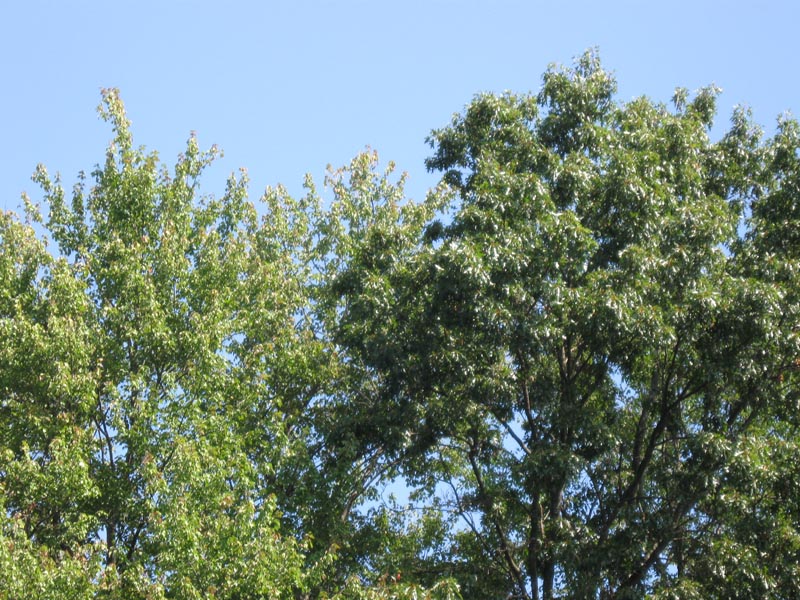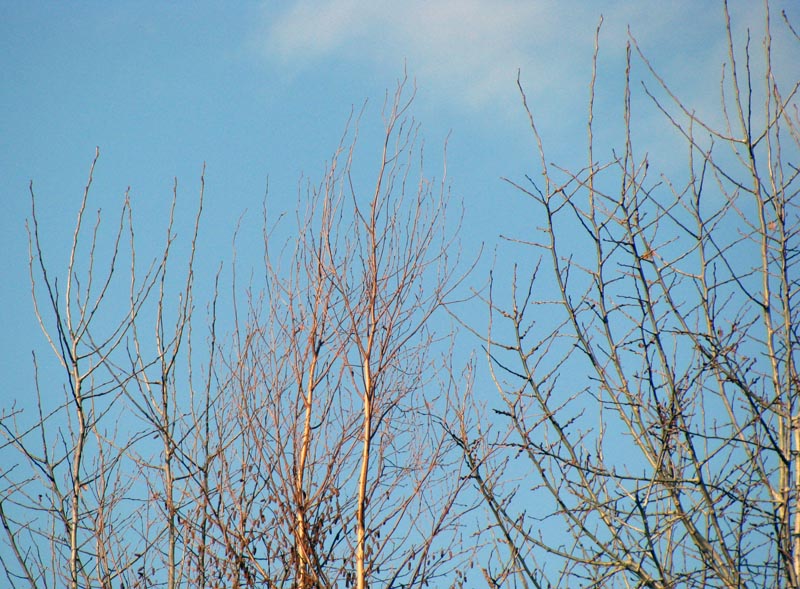Through this fall I’ve been talking about what I tried to accomplish in my new Guide to Trees. In essence, I tried to approach tree identification in the same way that modern birders approach bird identification, to create “a tree guide for birdwatchers”. Most guides to tree identification use keys at some level, which are simple and effective, but can be frustrating because the key forces us to answer a particular series of questions, and in the real world we often notice things that are simply not mentioned in the key. We might see trees like the ones in the photo below – clearly two different species – but a key forces us to begin by answering a question such as “Are the leaves opposite or alternate?”.

First, a little history:
A hundred years ago bird identification was accomplished with keys. Ornithologists carried shotguns, and birds could then be examined at very close range (and with no time constraints). The key emphasized clues like the shapes of scales on the legs – and the bird was identified .
Now we use binoculars. We look at the whole bird – color and shape, as well as posture, behavior, voice, habitat, and more – to make an identification. I wanted to create a tree field guide that used this holistic birdwatching-style approach.
Pros and cons:
This modern style of bird identification developed because we usually can’t examine the birds at length and in detail the way early ornithologists could, so a key to birds is simply not practical. Trees are easy to approach and study, and it’s always possible to use a key, but I think the holistic approach is a more satisfying and rewarding method of study.
- It encourages you to look at the whole tree and to find clues wherever they may be, even subtle differences such as branching structure that are difficult or impossible to describe in words.
- The holistic approach allows us to take advantage of “average” differences and probability, which a key (and its “either/or” questions) does not handle well.
- By emphasizing all aspects of appearance, habitat, phenology, etc. it leads to a better understanding of all of the differences and similarities between species.
- Looking at the whole tree you will quickly develop a sense of the overall patterns of variation: which field marks are more reliable, which are affected by environment, which are most useful for you.
- Without even realizing it you will begin to recognize the gestalt of each species, subtle features and combinations of features that distinguish alders, or aspens, or maples, etc. from all other trees (see photo below).
- By simply looking for patterns that match (and humans have very well-developed pattern-recognition abilities) we will notice new things, which will lead to new discoveries.
A key is analogous to a GPS device offering turn-by-turn directions. It gets you to your destination but without giving you a sense of where you are and what might be nearby. The Sibley Guide to Trees is more like a map, and one of my primary goals was to present the big picture and help put the species of trees in context.
Where to start?
Many people enjoy the certainty and the guidance provided by a key, and feel lost when they open a book and are confronted by hundreds of species of trees. It is important to understand that the species in The Sibley Guide to Trees are organized by family, which emphasizes the fundamental similarities within groups. Learning to recognize a maple, an oak, an alder, etc. greatly simplifies the identification process. If you really need a key, there are many excellent regional botanical references in print, which include detailed keys (but beware that many of these guides do not include cultivated species).
Just as in bird identification, it can be helpful to make your own list of “confusing species” that could occur in your local area. With a small investment of time you can page through the Guide to Trees and create a list of trees found in your area that have simple oval leaves (the most common and confusing leaf shape). Once you’ve done that I predict you’ll see that most of those species have other distinctive features, and the list is not so confusing after all. In the end the quickest and surest way to identify a confusing tree is to show it to an expert, and as you gain experience those “stumpers” will become less frequent, and more interesting.



As I read this I remembered your advice in Birding Basics to try to sketch the birds that you see, even if you don’t know how to draw. I couldn’t help but think of this while reading the post.
Of course you may actually say this in the new guide. I haven’t read it yet only because I’m waiting to see if I get it as a birthday present later this month. But if you haven’t suggested something like that it sure strikes me as a good idea: sketching and comparing general shapes of trees, specific leaves, twig structure, etc. It’s such a good way to see better, though I’m sure you know that well.
We were recently at Cape May talking an avid birder there who said one of his family might be getting your new tree guide but he certainly wouldn’t be reading it! A died in the wool birder and birder only. But my reaction especially after reading this post is that you’re really doing the world a great service with this guide, especially by trying to get people to look at trees in a new way. Over time even that avid birder may decide that he’s missing something and take another look at trees.
I finally got to open the Guide to Trees tonight, and I too hope people make lists using it. I made my own (actually based on one I made using your Guide to Birds) in Excel – it is a list only of the tree species I’d actually find in my local area (I determined this by looking at the range maps on each page), organized how you have them in the book – ‘Family’ in Column A, any breakdown by ‘Genus’ in Column B, the common name (and noting if it’s a non-native) in Column C, scientific name in Column D, and any other common names you had listed in Column E. I highlighted in green all species that appeared on the range map to cover the entire state/to be common. I immediately started recognizing how certain tree species I’d seen before were similar, I now have a simple highlighted list of species in my local area that are common so I can focus on those, and it even helped me realize that friends all summer were calling trees a different common name than one I actually knew. I made my birding spreadsheet list in May and it proved invaluable – in fact, people started asking for seasonal versions of it, especially after I updated it with the state Breeding Bird Atlas data for the counties my friends and I bird in.
I, for one, find the holistic approach you took to be intuitive, and I noticed on a lot of pages you illustrated parts of the tree almost anyone would naturally find interesting when first approaching it, but not just one or two, but all of them, giving a well-rounded approach. I often pick up acorns, cones, interesting colored or shaped leaves off the ground, and check out the shapes of trees – you put all of these things where they would be of interest.
I’m admittedly lacking in my ability to identify bare trees, and look forward to purchasing your guide so I can build my skills in that area. (It would be nice to be able to write in my winter journals that I spotted a bird in a ‘(fill in the _ tree’ instead of just ‘a tree’) 🙂 Although I’ve been a naturalist for all of my years, we’re never too old to learn. Thank you for helping so many do just that!
Mr. Sibley,
I heard you just published a new tree guide. Is this true?
Hi Marni, I did publish the Sibley Guide to Trees in fall of 2009. It still feels fairly new to me, as if it was “just published”, but that is the newest tree guide I have.
Best, David
Wow Mr. Sibley in the first picture up at the top I knew the left tree was a maple and the right tree was an oak. I could not id to species in that picture so I may need to buy your tree book.
Pingback: Hitchhiker’s Guide to Rhizo15 | Five Flames 4 Learning
Pingback: Review: The Sibley Guide to Trees
I agree. Depending on a key as a romantic naturalist in the landscape is impossible, and you would never develop any level of real expertise/intimacy in knowing each species. I’ve been expanding my natural interests this year and have not ceased to be amazed at the idiocy of the various guides available on trees, shrubs, grasses, ferns, beetles, dragonflies etc. The ones with keys in particular (like Petrides) are just stupid. The books I managed to get use out of included Peterson’s wildflowers, NE moths, Sibley’s trees, and Glassberg’s butterflies. I don’t have your book at the moment but I had some initial confusion over the local species in winter, I think because of regional differences in the bark and buds. I was also fooled into thinking a few trees I found were American elm because it said that layered bark is a characteristic trait. I thought your bird guides did a better job capturing the look and details of the birds for identification by impression for most (excepting SOSP and flying COGR), but I would never have been able to learn anything without your guide and it’s “holistic bird-watching” approach. “Holistic approach” tends to give a sense of insecure and subjective ID but it’s far more accurate and proper than by artificial means. I would call it the “normal” or “appreciative naturalist” way. “Holistic approach” would better apply in describing overall field guide design and layout, minimizing descriptive text and emphasizing good images.
Is the Sibley guide to tree identification ok for uk trees?